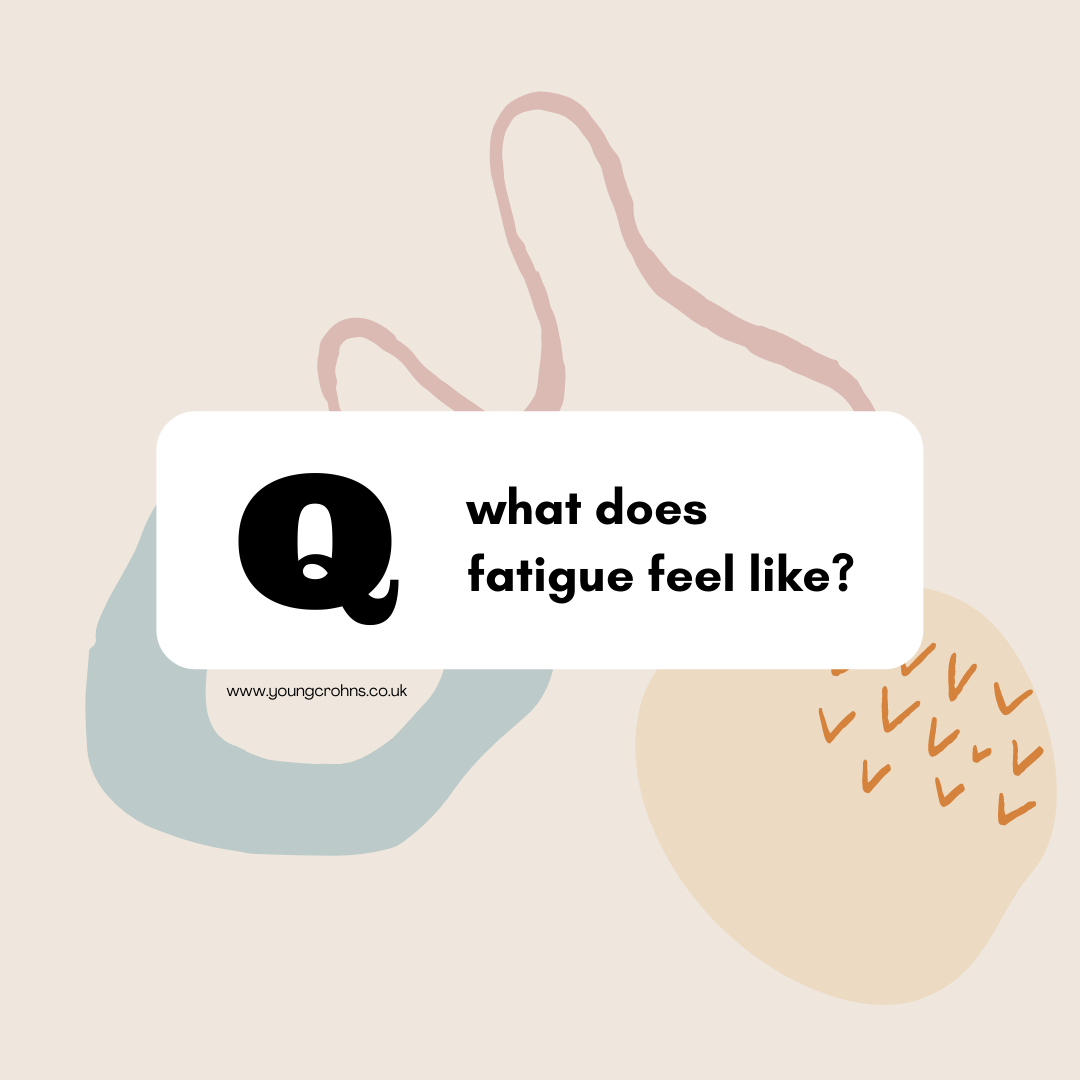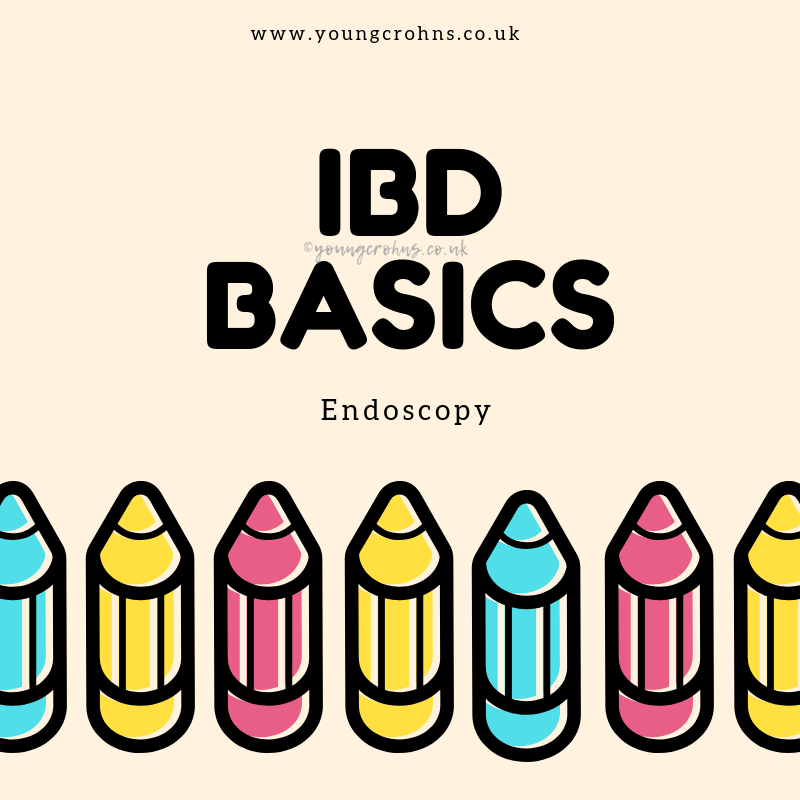
IBD Basics: Endoscopy
Disclaimer: This information is based on my own research into this particular aspect of IBD as well as some personal experience and should not be used as medical advice or a diagnostic tool. The suggestions given within are taken from sources laid out in the references header. If you seek advice regarding the things you experience within your own disease, please contact your IBD team for medical advice.
If you are looking for the entire ‘IBD Basics‘ series, you can find them all here.
Endoscopy: The When and Why
Diagnosing IBD is no easy task: it is a complicated disease which presents in very many ways. However, what should occur is your doctor will take your history and perform a physical exam. The physical exam will focus on the GI tract, including inspection of the anus and possibly a rectal examination. They may order various tests in order to make a diagnosis of IBD and help identify whether you have Crohn’s disease, Ulcerative Colitis, or Indeterminate Colitis.
These tests fall into several categories. Some are invasive – performed inside the body – while others are non-invasive and require only access to blood or stool samples or radiographic images of the suspected disease site. And although tests may seem intimidating at first, all are well tolerated by the vast majority of patients. Whilst blood tests can support the diagnosis of IBD, endoscopy plays the most important role. It helps your GI to see if inflammation is present, where it is located, assess its severity, and obtain biopsies to confirm the diagnosis. Endoscopy is also vital for monitoring your therapy. Healing of the lining of the intestine is a sign that your medication is effective.
What is Endoscopy & why is it important?
An Endoscopy is a procedure in which an instrument is introduced into the body to give a view of its internal parts.
An endoscope is a long, thin, flexible tube that has a light source and camera at one end. Images of the inside of your body are relayed to a television screen. Endoscopes can be inserted into the body through a natural opening, such as the mouth and down the throat, or through the bottom. Typically they are just called ‘scopes’ and are used in IBD diagnosis and management very often. It is likely, you’ll be subject to these tests quite a few times.
Here we shall be discussing FOUR types of Endoscopy procedures, commonly used in IBD:
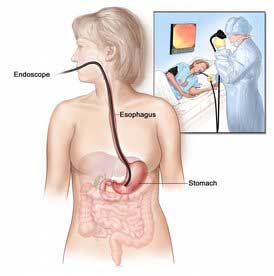 Upper GI – is also called OGD – Oesophago-Gastro-Duodenoscopy – or ‘gastroscopy’ or simply an ‘endoscopy’. This is a test which allows the doctor to look directly at the lining of the oesophagus, the stomach and around the first bend of the small intestine – the duodenum. In order to do the test, an endoscope is passed through your mouth into the stomach.
Upper GI – is also called OGD – Oesophago-Gastro-Duodenoscopy – or ‘gastroscopy’ or simply an ‘endoscopy’. This is a test which allows the doctor to look directly at the lining of the oesophagus, the stomach and around the first bend of the small intestine – the duodenum. In order to do the test, an endoscope is passed through your mouth into the stomach.

Capsule Endoscopy – this involves swallowing a small capsule – the size of a large vitamin pill, which contains a colour video camera, battery, light source and transmitter. The camera takes two pictures every second for 8 hours, transmitting images to a data recorder that patients wear around the waist.
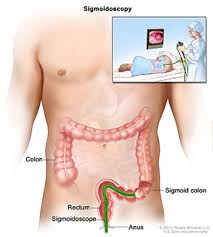 Flexi sigmoidoscopy – is commonly used to look for bleeding or non-cancerous growths, called polyps, in the colon and is one of the main screening tests for colorectal cancer. It is a common outpatient procedure in which the inside of the lower part of the large intestine – the sigmoid or left colon – is examined with a flexible video endoscope. During this procedure they may take biopsy using tiny forceps passed through the endoscope.
Flexi sigmoidoscopy – is commonly used to look for bleeding or non-cancerous growths, called polyps, in the colon and is one of the main screening tests for colorectal cancer. It is a common outpatient procedure in which the inside of the lower part of the large intestine – the sigmoid or left colon – is examined with a flexible video endoscope. During this procedure they may take biopsy using tiny forceps passed through the endoscope.
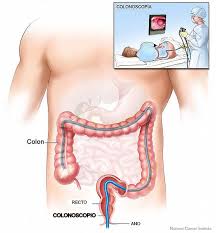 Colonoscopy – is a test which allows direct examination the lining of the large intestine. In order to do the test a colonoscope – a longer flexible tube, about the thickness of your index finger, is carefully passed through the anus into the rectum and advanced through the intestine; whilst the images of the inside of the colon are seen on a monitor, allowing the doctor to examine the lining of the colon for any disease or abnormalities.
Colonoscopy – is a test which allows direct examination the lining of the large intestine. In order to do the test a colonoscope – a longer flexible tube, about the thickness of your index finger, is carefully passed through the anus into the rectum and advanced through the intestine; whilst the images of the inside of the colon are seen on a monitor, allowing the doctor to examine the lining of the colon for any disease or abnormalities.
All four look at different sections of the digestive tract, because we know IBD – Crohns Disease in particular – can occur at point of the tract. Typically, colonoscopies are the biggest primary diagnostic tool when it comes to suspecting IBD involvement in a new patient but it is now not uncommon to have a Flexi sigmoidoscopy or a capsule endoscopy performed instead. This depends on several things, including – previous test results, location of disease, suitability for the testing and the ability for the test to be tolerated by the patient. Sometimes this will be done as in patient procedure, but most likely as out-patient.
How and why is it used to treat IBD?
Upper GI is used to look exclusively at the top end of the digestive tract – the mouth, the lining of the oesophagus, the stomach and the duodenum. It is a common procedure that physicians use to evaluate a wide variety of symptoms, including, but not limited to, upper abdominal pain, nausea, vomiting, and difficulty swallowing. An endoscopy requires fasting after midnight until the test. Crohn’s disease can occasionally affect the esophagus, stomach, and upper small bowel, which are investigated with an OGD.
Capsule Endoscopy a newer procedure that allows your doctor to obtain pictures of the entire small bowel. The capsule or “pill” camera contains a light source and camera surrounded by a protective outer shell. The capsule then travels through the small intestine and transmits approximately 60,000 images to the recorder. At the end of the day, the patient returns to the hospital for downloading of the images. The capsule is excreted in the stool normally. Capsule endoscopy is not recommended for patients with strictures or bowel obstructions as the capsule can become “stuck” or retained in the small bowel, resulting in symptoms of bowel obstructions and, rarely, requiring surgery. However, biopsies cannot be taken with the capsule.
Flexi sigmoidoscopy is an endoscopic evaluation of the lower one-half to one-third of the colon. This is useful when your doctor wants to confirm the presence of inflammation in this segment of the colon. In patients with Ulcerative Colitis, inflammation begins in the rectum; therefore, a sigmoidoscopy can be a good diagnostic test to confirm the disease and to monitor your response to therapy. It is usually performed without sedation, because it is a very short procedure and is associated with less discomfort than colonoscopy. The preparation for this procedure is less complex than an colonoscopy.
Colonoscopy is the type of endoscopy most often performed to both diagnose and monitor IBD. A colonoscope will be guided into your rectum and through the entire length of the colon and end of the small bowel – the terminal ileum. Typically, you will receive sedation prior to the procedure to minimise discomfort. Many patients sleep through the procedure and do not even recall that the test took place.
What they all have in common is the need for prep. This varies between procedures, but all require patients to have an empty system.
To allow a clear view during an upper GI, the stomach must be empty. You will therefore be asked not to have anything to eat or drink for at least six hours before the test.
The same applies for a capsule endoscopy, you will be asked to not have anything to eat for 18 hours prior to the test.
For a Flexi sigmoidoscopy, your rectum and lower bowels must be empty for the exam to be accurate and complete, but usually there are no diet or fluid restrictions before this procedure. To prepare the bowel for the procedure, an enema will be administered shortly after you arrive in the department by one of the nursing staff. Try to hold the enema for at least five minutes before releasing it. On occasion, you may have to drink an oral laxative as well.
To allow a clear view during a colonoscopy, the colon must be clean and completely empty of waste material. If it is not, certain areas may be obscured and the test may have to be abandoned and repeated at a later date. This test requires a bowel preparation of laxatives to evacuate the entire bowel. It is very important to take all of the laxatives prescribed – they do differ from hospital to hospital – and considerably increase your intake of clear fluids on the day before the examination, which will help clean the bowel. Please also follow the dietary instructions for the few days preceding the test, as this will also help to ensure the bowel is clean for the test.
***
When you arrive for your procedure, a doctor or nurse will explain the test to you and will usually ask you to sign a consent form. This is to ensure that you understand the test and its implications. Make them aware if you have had any allergies or bad reactions to drugs or other tests. They will also want to know about any previous endoscopy you have had. If you have any worries or questions at this stage don’t be afraid to ask, the staff will want you to be as relaxed as possible for the test and will not mind answering your queries. You may be asked to take off your shirt or jumper and to put on a hospital gown.
With the exception of the capsule endoscopy, these tests are performed in an endoscopy suite or department where they are set up for these tests. For an Upper GI, Flexi sigmoidoscopy and colonscopy, you can choose to do it with or without sedation. With sedation, you must not go home alone, you will be monitored for longer afterwards due to the drugs they use to sedate you, and must follow the post-procedure check list.
From here, they will take you into a procedure room and settle you on to a hospital trolley. They will cannulate if needed, then begin monitoring your vitals. For Upper GI, they spray the back of your throat with numbing spray to help the scope go down the gullet and insert a guide into your mouth so the scope does down. This procedure takes roughly 15 minutes. It is fairly uncomfortable, makes you gag, feel sick and generally is a very weird sensation. They like to not sedate patients for this because it can interfere with the ability to keep the oesophagus open, in some cases. You will have a sore throat for a while but afterwards, you will be allowed to eat and drink.
It is very similar for Flexi sigmoidoscopy and colonoscopy; you lie on your left side and await sedation prior to the scope being inserted. They will add air into your colon so they have a clear picture and so they can navigate through your colon and into your terminal ileum if having a colonoscopy. This can be an uncomfortable procedure to endure if you are symptomatic but it is very good at showing the level and depth of inflammation. These tests will determine treatment needed, monitor current treatment and can determine the location of strictures and adhesions.
Capsule endoscopy still takes place in hospital but due to the fact they need 8 hours of recording of your full digestive tract, most appointments begin very early and you are monitored once the capsule has been swallowed, so they are certain the recorder is live. You are asked to return at the end of the day, detach from the receiving pack and the capsule will pass naturally.
Side Effects & Important Information
- Colonoscopies are generally very safe procedures, but there is an extremely small risk of bowel perforation during the exam. You may want to discuss the risk with the doctor performing the test.
- Many patients ask about the usefulness of less invasive “virtual colonoscopies.” Although these radiology-based tests are an exciting new development, they are not recommended for suspected IBD, where biopsies and direct viewing of the colon and small bowel are required.
- The pill cam from capsule endoscopy is usually passed from your body naturally, but in rare cases it can get stuck if there is a blockage in your intestine.
- Symptoms to look out for from all of these procedures are: acute abdominal pain or vomiting, temperature greater than 38 degrees, redness, tenderness and swelling at the site of the intravenous injection that persists.
- If you have had any biopsies taken or polyps removed, you may notice small traces of blood coming from your back passage. If the bleeding persists, becomes more severe or the abdominal pain becomes worse, you should contact your local hospital; taking a copy of your endoscopy report with you.
- If you have had sedation it is sensible to avoid alcohol in combination with it. Normal food can be taken after the examination but you may prefer light meals on the day of the examination.
- As you have had your colon completely emptied, you should not expect necessarily to start to have normal bowel function for two to three days. Bowel actions after that should rapidly return to normal.
- You may resume normal medications immediately after your colonoscopy but if a polyp was removed we may advise against taking certain blood-thinning or anti-inflammatory drugs for a defined period
- In preparation for a colonoscopy you will be provided with bowel preparation. There are various brands of the strong laxative and you may either be given a laxative called sodium picosulphate (Picolax or CitraFleet), or a different bowel preparation, such as Klean-Prep or Moviprep.
- Please note that the instructions are different depending on which strong laxative your doctor has prescribed you – please make sure you read the bowel preparation leaflet from your own hospital, as they will have particular ways . The times that you need to take your medicine will also depend on whether you are having your colonoscopy in the morning or afternoon.
My Experience
I was diagnosed with Crohn’s Colitis back in September 2011 with a Flexi Sigmoidoscopy. Since then, I’ve had four Flexi sigs, three OGDs, three colonscopies and one failed attempt at a capsule endoscopy.
For all these tests, I’ve done the prep, endured the sedation and had both good and bad results from each these tests. They’ve determined my diagnosis, my treatment, my extra diagnosis – a lovely hiatus hernia back in September 2014 with a brand new GI – and shown me how wonderfully inflamed my guts truly were. It was somewhat of a relief because I actually saw how much pain I was in, not just feeling it. Eventually, a OGD and an attempted colonoscopy would be the shove I needed for my subtotal colectomy. They couldn’t advance the scope any further than my sigmoid due to the damage but they decided a NG tube under sedation would the best way forward then too.
In more recently times, with the removal of my colon, I’ve had a Flexi sig and a failed OGD; both confirming that my biologic treatment was working but I wasn’t having actual rectal issues, it was just nerve damage so my stump would remain until it aggravates me once more.
Lately though – in the past almost three years – I’ve seen my disease being monitored better with scans than scopes. For me, a small bowel MRI is a breeze, compared to the preparation I would under go for a colonoscopy. Very glad my sans colon existence allows me this small pleasure; no colon, no colonscopy! I have yet, however, had the need for a ileoscopy – an endoscopy procedure through the opening of my stoma.
Scopes I can look back with some hindsight and fondness now that I don’t have to have them done but I understand and respect the diagnostic tool they are and the weight they carry for determining IBD. Whilst unpleasant and feared by many, I haven’t experienced anything too horrible, at the hands of the Endoscopy team. What I’ve found key is making sure you are crystal clear on your prep, your procedure and always take the drugs. They make it a bit more pleasant but it gives you a nice bit of a memory blank during it too; nice and fuzzy.
I’ve written about them too! Here are the ‘collection’ of posts:
- Exploring Bernie – 18.12.12
- Prep Day – 20.12.12
- Result – 24.12.12
- Polyps and Prep – 26.03.13
- After all this time … MRI – 03.04.13
- Moviprep: The storm before the Scope – 07.03.16
- Colonoscopy – 08.03.16
- MRI Scan: Small Bowel Study – 19.01.17
- GI Clinic & MRI Scan – 27-28.06.17
Have you had an endoscopy before? Have you found them useful for your IBD treatment plans? Any bad experiences?
Do you have any questions or queries? Or just want to share your own experiences? Leave me a reply or tweet me @sapphire20 or find my blog page on Facebook!

Sources:
Crohn’s and Colitis Foundation – Diagnosing and Managing IBD
NHS – Endoscopy
St Marks hospital – Upper Gastrointestinal Endoscopy – Colonoscopy – Flexi Sigmoidoscopy – Video Capsule Endoscopy
Guys and St Thomas’s NHS Foundation Trust – Dietary Advice and Bowel Preparation (pdf)
British Society of Gastroenterology – Endoscopy Guidance


